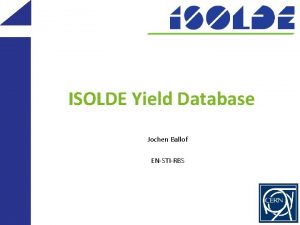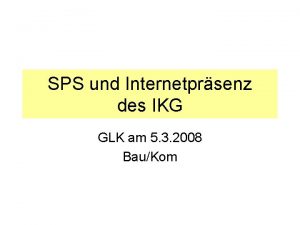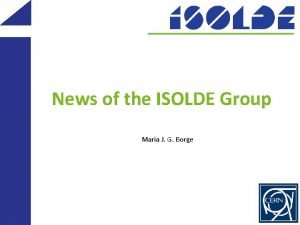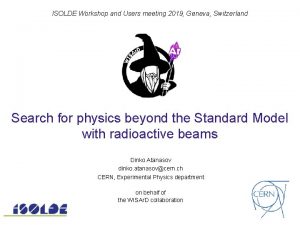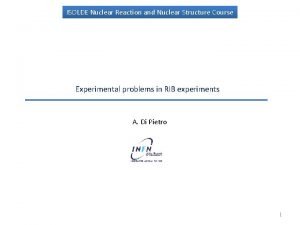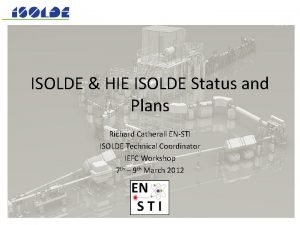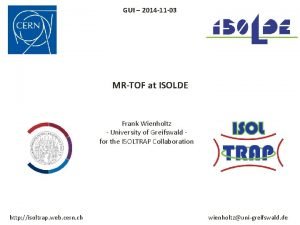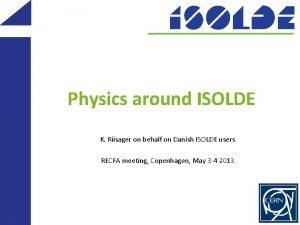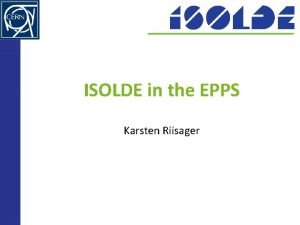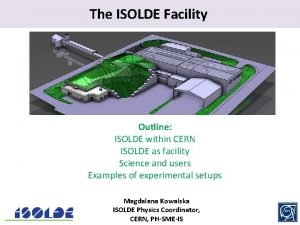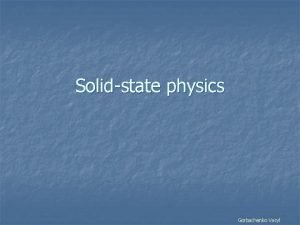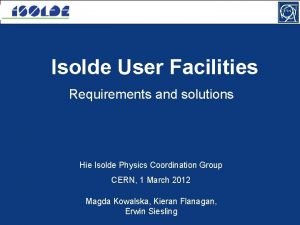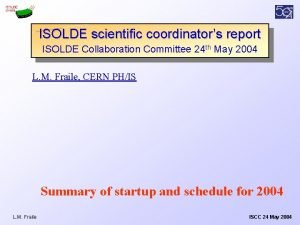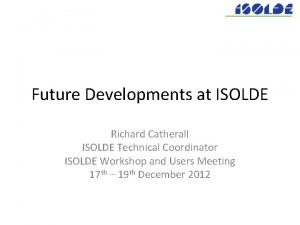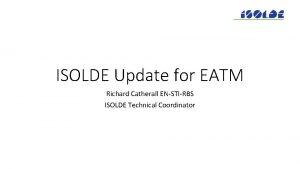SolidState MARX Type Circuit for the ISOLDE Target






![Positive Solid-State Marx generator operation Topology Charging mode [2] L. M. Redondo, J. Fernando Positive Solid-State Marx generator operation Topology Charging mode [2] L. M. Redondo, J. Fernando](https://slidetodoc.com/presentation_image/4e1b33fd93fcc97deac70d7fefce1850/image-7.jpg)







- Slides: 14

Solid-State MARX Type Circuit for the ISOLDE Target Voltage Modulator L. M. Redondo*, J. Fernando Silva#, H. Canacsinh*, N. Ferrão*, C. Mendes*, R. Soares†, J. Schipper† and A. Fowler† * Nuclear Physics Center - Lisbon University (CFNUL), Lisbon, Portugal # Center for Innovation in Electrical and Energy Engineering – TU Lisbon, Portugal † ABT Group, TE Department, CERN, Switzerland Work supported by FCT project CERN-FP-83497 -2008 22 Set 2009 1

Summary • ISOLDE Target Voltage Modulator (the actual system, the issues, the motivation); • System requirements and new concept; • Proposed solid-state modulator; • Prototype layout and experimental results • Conclusions and future work 22 Set 2009 2

ISOLDE Target Voltage Modulator The On-Line Isotope Mass Separator facility uses the 1. 4 Ge. V proton beam (up to 2 µA ) from the PS-booster at CERN to bombard a target and produce a wide range of isotopes. To provide the needed acceleration, the target and ion source must be held at a precise voltage (60 k. V± 1 V), with respect to a grounded extraction electrode, if there is to be high mass resolution in the downstream separator. The impacting proton beam intensively ionises the air. This ionisation perturbs the accelerating voltage because it represents a significant additional load on the power supply. 22 Set 2009 3

ISOLDE Target Voltage Modulator 60 k. V During the critical period when protons strike the target the accelerating voltage is modulated to zero. This is acceptable provided that the stable accelerating voltage of 60 k. V +/- 1 V is interrupted for less than 10 ms, so still allowing the detection of very short life-time radio isotopes. [3] D. C. Fiander, A. Fowler, in 20 th Power Modulator Symposium, 1992, pp. 173 -176. At present a custom-built positive 60 k. V d. c. power supply (PS), Imax<40 m. A, is connected, via a pulse transformer and a hard-tube switch (tetrode), to a resonant circuit such that prior to beam impact the target is fully discharged by the resonant circuit in 35µs, which then restores the voltage close to its nominal value within a further 200µs. Finally, returns to its nominal value ± 1 V within 5 to 6 ms. 22 Set 2009 4

ISOLDE Target Voltage Modulator The high precision, high stability power supply PS 2, is connected to C 2, almost two orders of magnitude greather than C 4 (load), for minimising the voltage excursion. The current limitation on the 60 k. V PS limits the circuit performance. C 4 voltage C 2 voltage 22 Set 2009 To ensure future physic requests, such as the power increase of the proton beam, for both negative and positive short life-time radio isotopes ion beams, necessary improvements must be made on the existent modulator circuit. 5

System requirements and new concept The 60 k. V PS, the device that controls the accuracy of the target voltage, must be shielding against any voltage variations. The new circuit concept uses the actual 60 k. V PS and two auxiliary high voltage switches, based on the solid-state Marx modulator concept: • one in series, S 1, between the PS and the load, R 0/C 0, which disconnects the PS from load prior to proton beam impact; • another one in parallel, S 2, with the load that discharges it to zero (position 1), recharging it to full voltage afterwards (position 2), just before the 60 k. V PS takes control again of the load voltage stability. 22 Set 2009 6
![Positive SolidState Marx generator operation Topology Charging mode 2 L M Redondo J Fernando Positive Solid-State Marx generator operation Topology Charging mode [2] L. M. Redondo, J. Fernando](https://slidetodoc.com/presentation_image/4e1b33fd93fcc97deac70d7fefce1850/image-7.jpg)
Positive Solid-State Marx generator operation Topology Charging mode [2] L. M. Redondo, J. Fernando Silva, P. Tavares and E. Margato, in IEEE 36 th PESC Conf. , 2005, pp. 1170 -1174. Pulse mode 22 Set 2009 7

Proposed Solid-State Modulator Two n stages solid-state Marx generators, operating, respectively, as a series (Marx 1) and parallel (Marx 2) switch. 22 Set 2009 8

Proposed Solid-State Modulator Mode 1, time t 0: • Tci in Marx 1 are on, the Ci capacitors in Marx 1 are in parallel; • Tci and Tpi in Marx 2 are off, Ci capacitors are in series, through the Tpi anti-parallel diodes, distributing the voltage across Tci. • Capacitor Cdc voltage, vc, is applied to the load, v 0. 22 Set 2009 9

Proposed Solid-State Modulator Mode 2, time t 2: • Tci in Marx 1 are off, vc appears between the terminals, and is sustained by the Ci capacitors in series through the diodes Dpi, distributing the voltage across the Tci. • Tpi and Tci in Marx 2 are, respectively, off and on; • The load is discharge to zero. 22 Set 2009 10

Proposed Solid-State Modulator Mode 3, time t 3: • Tci in Marx 1 are off; • Tpi and Tci in Marx 2 are, respectively, on and off, and the Marx 2 applies a voltage to the load, charging it; • The load is charged to about ~n. Udc 2. 22 Set 2009 11

Prototype layout 10 k. V, prototype 10 stages 1 k. V Marx 1200 V IGBTs, diodes and capacitors Front Back Marx 1 22 Set 2009 Marx 2 12

Load voltage Experimental results 10 k. V, prototype Udc=10 k. V, Rdc=2. 7 kΩ, Cdc=200 n. F Udc 2=1 k. V, Rdc 2=1 kΩ R 0=14 MΩ, C 0=2 n. F Ci=1 μF, with 1. 8 MΩ in parallel ~ 20 Hz, t 0=50 ms, t 2=254 μs and t 3=10 μs 2000 V/div 10 ms/div Load voltage 2000 V/div 22 Set 2009 100 μs/div 250 μs reset time, 250 ns rise and fall times 40 k. V/μs slew rate. 3 ms recovery time 2000 V/div Cdc voltage 10 ms/div 13

Conclusions and future work • A new solid-state Marx type topology was proposed for the ISOLDE Target Voltage Modulator; • Solid-state Marx generators were used as serial and parallel switches; • The new topology minimizes the effects on the PS from the load voltage excursions • Preliminary results, from a 10 k. V prototype, were presented with two, ten stages 1 k. V, Marx generators, with 1200 semiconductors; • Voltage ripple is, mainly, due to the parameters R 0/C 0 and Rdc/Cdc of the system as well as the value of the resistors connected in parallel with the Ci capacitors in the two Marx generators; • It is mandatory to further increase the voltage amplitude to near the 60 k. V regime and test the circuit in the off-line target. 22 Set 2009 14

